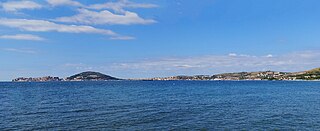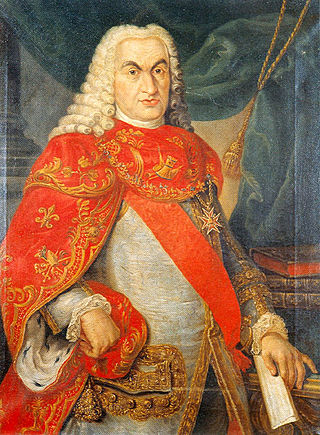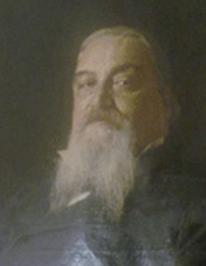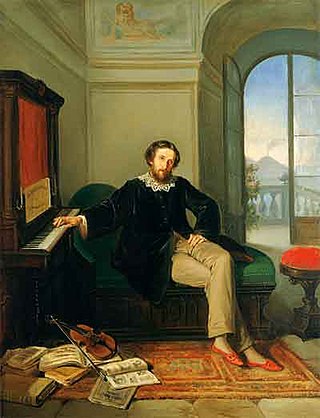
Gaeta is a seaside resort in the province of Latina, in Lazio, Italy. Set on a promontory stretching towards the Gulf of Gaeta, it is 96.5 kilometres from Rome and 133 km (83 mi) from Naples.

Bernardo Tanucci was an Italian jurist and statesman, who brought an enlightened absolutism style of government to the Kingdom of the Two Sicilies for Charles III and his son Ferdinand IV.

Sebastiano Conca was an Italian painter.

Belisario Corenzio was a Greek-Italian painter, active in Venice and Naples. He is one of few Greek painters that did not belong to the Cretan Renaissance like his contemporaries of the time. He escaped the maniera greca completely. He adopted the Venetian style. Other similar Greek painters were Marco Basaiti, Ioannis Permeniates, Antonio Vassilacchi and El Greco. He was sometimes referred to as Il Greco. His teacher was prominent Venetian painter Tintoretto. In 1590, at age 32 Corenzio settled in Naples. Corenzio was influenced by Cavalier d'Arpino. He continued to flourish in the region. His apprentices included: Luigi Rodriguez, Andrea di Leone, Onofrio De Lione and Massimo Stanzione. Corenzio painted many frescos that survived today. Some of his works are in the Church of San Severino and Certosa di San Martino. His style resembles Caravaggio. An Italian legend in Naples exists involving Corenzio, Spanish painter Jusepe de Ribera, and Battistello Caracciolo. They were referred to as the Cabal of Naples. The three painters were rumored to have poisoned their competition for painting contracts. The rumors lack documented evidence. The three painters were very popular in Naples. Corenzio frescoed the Crypt that holds the remains of Matthew the Apostle at Salerno Cathedral and it depicts scenes from the Gospel of Matthew. Corenzio was one of the most celebrated fresco painters in Naples during his time. His drawings can be found all over the world namely at the Metropolitan Museum, Museo di Capodimonte and Louvre. More recently, his life and work was studied by the Greek art historian Panayotis K. Ioannou in a comprehensive monograph.
Formia is a city and comune in the province of Latina, on the Mediterranean coast of Lazio, Italy. It is located halfway between Rome and Naples, and lies on the Roman-era Appian Way.

Ludovico Sabbatini was an Italian priest and religious educator, who was beatified by the Catholic Church in 1765. He is venerated on 11 June, the day of his death.

Bernardino Poccetti, also known as Barbatelli, was an Italian Mannerist painter and printmaker of etchings.

The Diocese of Cuneo is a Latin diocese of the Catholic Church in Italy. It was created in 1817, from territory that previously had belonged to the Diocese of Mondovì. It is suffragan of the Archdiocese of Turin. The first bishop of Cuneo was Amedeo Bruno di Samone from 1817 to 1838.
Tommaso Malvito was an Italian sculptor, known particularly for his work on funerary monuments in Naples at the turn of the fifteenth and sixteenth centuries.
Ascanio Mayone was a Neapolitan composer and harpist. He trained as a pupil of Giovanni de Macque in Naples, and worked at Santissima Annunziata Maggiore there as organist from 1593 and maestro di cappella from 1621; he was also organist at the royal chapel from 1602. He published madrigals, but his main work is his two volumes of keyboard music, Capricci per sonar. These contain canzonas, toccatas, variations, and arrangements of vocal pieces, many of which are distinctively Baroque rather than Renaissance in style.

Giacinto Brandi was an Italian painter from the Baroque era, active mainly in Rome and Naples.

Duke or Duchess San Donato was a noble title, first created in 1602 by the Spanish King Philip III for the House of Sanseverino. The duchy was traditionally based on estates and territories held in San Donato di Ninea, Calabria. The first creation, however, lasted only 52 years. In 1668, the title was recreated for a wealthy merchant, Antonio Amitrano, who had some years earlier bought the feudal rights over the former dukes' territories. Descendants of the Ametrano family held the duchy, as one several titles, until it became extinct in the 1970s. There have been successive claims over the centuries by distant kinsmen of the first holders to claim the duchy; these remain unverified.

Christianity and religion in general has always been an important part of the social and cultural life of Naples. It is the seat of the Archdiocese of Naples, and the Catholic faith is highly important to the people of Naples and there are hundreds of historic churches in the city. The Cathedral of Naples is the most important place of worship in the city, each year on September 19 it hosts the Miracle of Saint Januarius, the city's patron saint. In the miracle which thousands of Neapolitans flock to witness, the dried blood of Januarius is said to turn to liquid when brought close to relics said to be of his body: this is one of the most important traditions for Neapolitans.
Scipione Stella was a Neapolitan composer. He is to be distinguished from another member of the circle of Carlo Gesualdo, Scipione Dentice.
Giovanni Battista Cavagna, also known as Cavagni or Gavagni was an Italian architect, engineer, and painter, active mainly in Naples, but also in Rome and the Marches of Italy.

Michelangelo Naccherino was an Italian sculptor and architect, active mainly in the Kingdom of Naples, Italy.

Vincenzo Pasquale Angelo Petrocelli was a Neapolitan artist. Petrocelli was born in Cervaro in the Kingdom of the Two Sicilies. He studied under Domenico Morelli, and was active as a painter from about 1850. He was principally a history painter, but also painted portraits and genre scenes. His sons Achille and Arturo were both painters.

Francesco Fiorentino was an Italian philosopher and historiographer.

Gabriel Ferretti was an Italian Roman Catholic priest and a professed member of the Order of Friars Minor. He was an ancestor to both Cardinal Gabriele Ferretti and Pope Pius IX having been descended from a long noble lineage. Ferretti entered the religious life after becoming of age and soon after his ordination held two important leadership positions in the order. He set about restoring run down Franciscan convents in the region as well as seeing to the establishment of new ones to deal with an influx of new novices.

The Cappella di San Luca, also called dei Pittori is a chapel found in the cloisters of the convent of Santissima Annunziata in Florence, Italy. It was built to serve as the burial chapel for members of the Accademia delle Arti del Disegno, and was donated by the Servites to the Academy in a document from 1565. It contains a collection of terracota statues from a number of prominent Florentine Mannerist sculptors.















